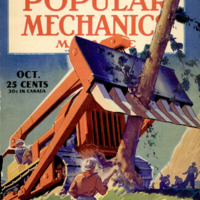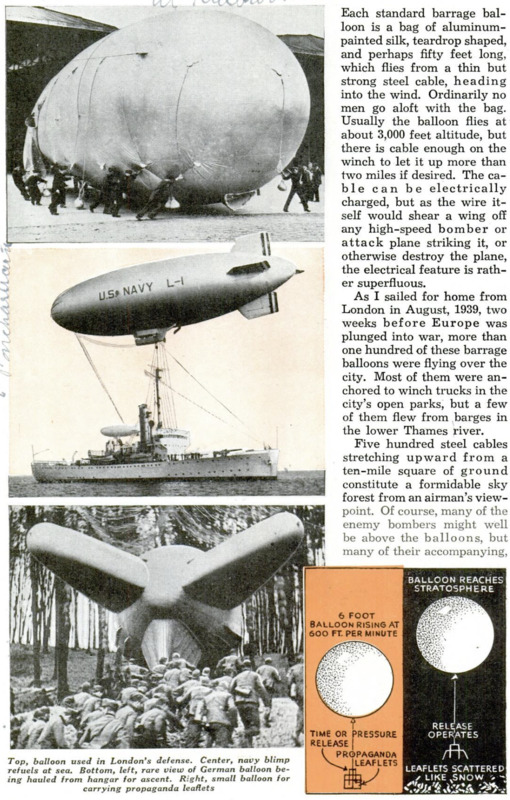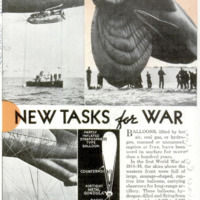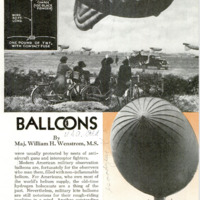BALLOONS, lifted by hot air, coal gas, or hydrogen, manned or unmanned, captive or free, have been used in warfare for more than a hundred years. In the first World War of 1914-18, the skies above the western front were full of large, sausage-shaped, captive kite balloons, carrying observers for long-range artillery. These balloons, hydrogen-filled and flying from a steel cable at 3,000 to 5,000 feet, were attractive but dangerous targets for the fighter-airplane pilots of those days - attractive because they would burst into great gobs of orange flame when pierced by tracer bullets, dangerous because they were usually protected by nests of anti-aireraft guns and interceptor fighters. Modern American military observation balloons are, fortunately for the observers who man them, filled with non-inflammable helium. For Americans, who own most of the world’s helium supply, the old-time hydrogen holocausts are a thing of the past. Nevertheless, military kite balloons are still notorious for their rough-riding qualities in a wind. Another outstanding American balloon improvement is the motorized observation balloon, which cruises like a “blimp” under its own power to the observation station. Upon arrival there, a motor gondola is replaced by the standard observation basket, and balloon and observers are let up on a cable. A recent development in captive kite ballyons is the British balloon barrage. Each standard barrage balloon is a bag of aluminum-painted silk, teardrop shaped, and perhaps fifty feet long, which flies from a thin but strong steel cable, heading into the wind. Ordinarily no men go aloft with the bag. Usually the balloon flies at about 3,000 feet altitude, but there is cable enough on the winch to let it up more than two miles if desired. The cable can be electrically charged, but as the wire itself would shear a wing off any high-speed bomber or attack plane striking it, or otherwise destroy the plane, the electrical feature is rather superfluous. As I sailed for home from London in August, 1939, two weeks before Europe was plunged into war, more than one hundred of these barrage balloons were flying over the city. Most of them were anchored to winch trucks in the city’s open parks, but a few of them flew from barges in the lower Thames river. Five hundred steel cables stretching upward from a ten-mile square of ground constitute a formidable sky forest from an airman’s viewpoint. Of course, many of the enemy bombers might well be above the balloons, but many of their accompanying, low-flying attack planes, to say nothing of low-flying “sneak bombers,” would be caught and destroyed. And in poor visibility and bad weather, when the enemy is most likely to attempt a “blind” raid, this forest of steel cables would be a terrific mental hazard for every enemy pilot. The greatest and most spectacular free balloon ever séen was the National Geographic Society’s “Explorer IL” in which Captains Stevens and Anderson of the U. S. Army ascended in 1935 from the Black Hills of North Dakota. They refiched an all-time world’s altitude record for aeronauts of nearly fourteen miles. Less spectacular than the great man-carrying balloons, but cheap enough and simple enough to be within experimental reach of any American free-lance inventor, are pilot balloons and sounding bal.loons - hydrogen-filled spheres of thin rubber, a few feet in diameter, that will carry up various small devices weighing not more than a few pounds. These smaller sounding balloons, incidentally, really hold the world’s “altitude record” for man-made objects - somewhere around twenty-five miles - and probably will continue to hold it until the development of workable sounding rocket. The ordinary pilot balloon in universal use at most air-line terminals today is simply a thin-rubber, hydrogen-filled sphere that starts with a diameter of about two and one-half feet. By day it is released alone; by night it carries aloft a small candle lantern or electric light. The released balloon, ordinarily inflated so as to rise at about 600 feet per minute, is sighted on by two theodolites located along a measured baseline on the ground (or by only one theodolite if the rise rate is accurately known). The successive plotted positions of the balloon, from minute to minute, give an accurate determination of upper winds at all levels. Data on these upper winds are essential to modern aviation, both military and civil. They are also essential to heavy artillery in wartime. A larger and faster-rising balloon is the “high-pilot.” Inflated to perhaps forty ounces of free lift and a diameter of slightly over three feet, the balloon will carry aloft any weight up to about ten ounces at a rise rate of 1,200 feet per minute. At around 40,000 feet altitude, having expanded to a diameter of eight feet or so in the rarefied upper air, the balloon bursts. From 1935 to 1937 the U. S. Army Meteorological Service made hundreds of test ascents with these high pilots. They even burst several of the balloons at high altitudes with timed charges of black powder, foreshadowing the aerial mines of the present war. But when fog or clouds intervene between theodolite and balloon, upper winds have been satisfactorily found so far only by very expensive methods, such as flying an airplane along a drifting line of shell-bursts (above the clouds). Here is where the “raypilot” comes into its own. In principle it is only a miniature radio transmitter hanging below the rising balloon. As it rises beyond the clouds, its successive positions in space are plotted from radio bearings taken by directional receivers. Still far from perfect, despite plenty of research attention from government laboratories, the raypilot offers many opportunities to inventors qualified in radio and surveying. Only the balloon itself and a miniature radio transmitter are necessary at the sending end - the whole combination probably costing less than three dollars. One upper-air quality that artillery officers must know for accurate shooting is “ballistic density.” The density of the air, which affects the flight of the projectile, depends mostly on its temperature, but partly also on its moisture content. Therefore heavy artillerymen are interested in the existing values of temperature and humidity of all the air levels through which their big shells will be fired. The simplest and quickest way of finding this ballistic density, up to altitudes of less than 20,000 feet, is by means of a sounding airplane. In a streamlined aluminum case, well out from the fuselage of the plane, are two large and easily read instruments - a thermometer and a hygrometer. As the pilot climbs steadily, the observer notes the readings of temperature and relative humidity at 500-foot intervals on his altimeter, and either notes them down or radios them to the ground. But above 20,000 feet the time, trouble and expense of airplane sounding increase out of all proportion. Hence the “raysonde.” This device is carried up to heights of ten miles or more by a rubber balloon, somewhat larger than the high-pilot, which starts at a diameter of about six feet. Raysondes are now sent aloft by the U. S. Weather Bureau in the early morning, day in and day out, from several upper-air sounding stations scattered over the United States. These robot raysondes rise at 600 to 1,200 feet per minute, and send out a radio signal which is translated by an elaborate ground receiver into the values of upper atmospheric pressure, temperature and humidity being encountered by the balloon. This information is essential to modern, accurate, air-mass and front-analysis weather forecasting. Still another wartime small-balloon idea, already considered by the British, involves the simultaneous release of thousands of small meteorological balloons as “aerial mines” against enemy airplanes. In the present form of the device, each balloon carries aloft, hung beneath it by a length of wire, a pound or so of TNT or other high explosive in a can fitted with sensitive contact fuses. The rising balloon, of course, drifts off to leeward with the prevailing wind, and continues to rise until it bursts. Any one of these small aerial mines would be capable of destroying any airplane hitting it, or even brushing by it. Still another wartime job for these small balloons might be in carrying propaganda leaflets. Each little propaganda-balloon could carry, say, a pound or so of small leaflets. By some cold-proof clock or other mechanism yet to be perfected, the balloon could perhaps be made to release its leaflets in the stratosphere after two or three hours of flight. The leaflets would then be scattered over enemy territory.
 Popular Mechanics, v. 74, n. 4, 1940
Popular Mechanics, v. 74, n. 4, 1940







